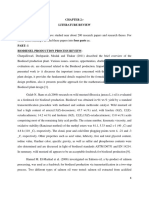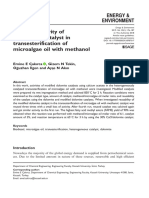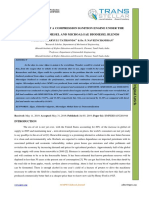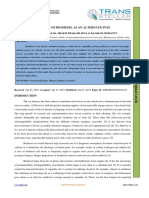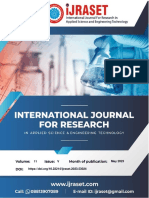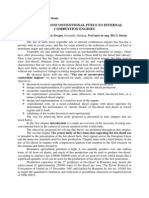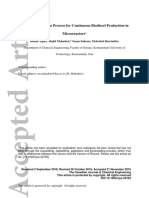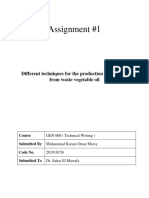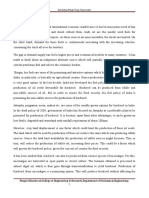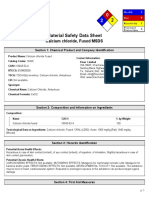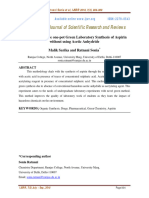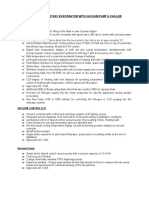Alcoholysis of Algae Oil To Produce Biodiesel
Alcoholysis of Algae Oil To Produce Biodiesel
Volume 9, Issue 3, March – 2024 International Journal of Innovative Science and Research Technology
ISSN No:-2456-2165 https://doi.org/10.38124/ijisrt/IJISRT24MAR1377
Alcoholysis of Algae Oil to Produce Biodiesel
Adeosun N O Olanrewaju A O
Chemistry Education Department, Chemistry Education Department
Federal College of Education (T) Asaba. Federal College of Education (T) Asaba.
Madaki S.D Ugboh E.
Computer Science Department, Computer Science Department,
Federal College of Education (T) Asaba. Federal College of Education (T) Asaba.
Abstract:- A technically and financially viable solution to I. INTRODUCTION
the numerous issues associated with fuel scarcity and high
cost is biodiesel. Algae biofuels represent a highly The need to find a substitute fuel has grown due to
promising alternative approach to energy generation. factors like environmental concerns, rising oil prices, and
Microalgae have been proposed as a viable alternative for reliance on foreign oil. The sustainable alternative energy
fuel production due to high oil content in their cells, source that garners the most attention in the present situation
making them suited for development as a material source is biodiesel, owing to its advantageous characteristics
for biodiesel manufacturing. This study used dry green including being easily biodegradable and ecologically
algae mass (Chlorophyceae) that was grounded into a beneficial. Oil obtained from algae is a renewable resource
smooth powder which was obtained from Delta state. A alternative to petroleum fuels, natural gas, and petroleum.
total of 100g of powder were measured. Also, biodiesel derived from oil crops is a possible renewable
and carbon neutral fuel (6, and 8). However, renewable oils
Algae oil extraction was done using lipid extraction. are not a strong rival to petroleum fuels because of their high
Additionally, acid esterification was the first step in the price and scarce availability.
characterization of biodiesel. Using a standard solution of
1.0M NaOH solution, the acid value of the reaction The use of vegetable oils gained popularity in the early
mixture was measured using a standard acid base titration 1980s due to concerns about the environment, energy security.
method. The results showed that the acid value was Since there is overproduction in agriculture, trans
0.280%, the iodine value was 128.592 mg/l, the specific esterification was found to be the most effective way to
gravity was 0.8103, the density was 0.8099 g/ml, the produce vegetable oils in place of petroleum fuels, as the latter
refractive index was read off as 1.41, the cloud points were became more expensive and less abundant. Investors and
-50C, the smokes were 2440C, and the flashes were likewise consumers started to find biodiesel becoming more attractive
288oC. (21, 15).
Using USA-based Buck Scientific M530, the analysis In the early 1990s, Martin Mittelbach was a member of a
method employed was FTIR, and FTIR spectra were co- group of pioneering researchers that worked on the creation of
added at 32 scans with a resolution of 4 cm-1. The spectra the biodiesel fuel industry in Europe and South Africa;
were collected at frequency areas of 4,000 – 600 cm-1. with the U.S. industry developed more slowly (17, 16). In
Transmitter values representing FTIR spectra were 1996, Pacific Biodiesel manufacturing production facility on
shown. Trans esterification is the technique used to turn the Hawaiian island of Miami to convert re-used cooking oil
algae oil into biodiesel. This was carried out in a round- into biodiesel, become one of the first biodiesel facilities in the
bottom flask with a magnetic stirrer and condenser using United States due to decreased pricing for petroleum fuel. (14,
catalyst that was supplied (three percent weight of the oil). 9).
Curves that are analytical were created. The
determination of the diglycerides and triglycerides was The Environmental Protection Agency (E.P.A.)
made possible by the analytical curves from diolein and estimated that algae is the only type of biofuel modelled to
triolein. After the product was dried at 800C in a vacuum date. Fatty acid methyl trans-esterification can reduce
evaporator, a clear and pure biodiesel was obtained. greenhouse gas emissions by more than 60 percent when
compared to petroleum diesel (19, 20). While using
microalgae as a fuel source is not a novel idea, the rising costs
of diesel and the effects of global warming have recently
propelled this solution to the top [2, 7].
IJISRT24MAR1377 www.ijisrt.com 1485
Volume 9, Issue 3, March – 2024 International Journal of Innovative Science and Research Technology
ISSN No:-2456-2165 https://doi.org/10.38124/ijisrt/IJISRT24MAR1377
Chemistry classes in high school can be tedious and smooth powder by a small grinding machine for 1hr.30
challenging. However, if students perceive a means to alter the minutes which weighed 100g.
world, that tedious and difficult laboratory work in chemistry
may become an interesting and fun subject. A technically and Weighed sample was extracted using 500ml n-hexane in
financially viable solution to the numerous issues associated a soxhlet extractor (UNE-EN 734-1, 2006) for 5 hours. The
with expensive gasoline and shortage is biodiesel. Because extracted oil was placed in water bath at low temperature to
microalgae cells contain a lot of oil, they can be used as a evaporate the n-hexane from the extract. Extracted algae oil
material source for the manufacturing of biodiesel (13, 11). was weighed and stored in an air tight jar to avoid oxidation.
This prompted the researchers to investigate these procedures Lipid yield was calculated with this equation:
and turn algae mass into biodiesel. Students would gain
knowledge of the procedures used to produce biodiesel from Mass of Lipid
%𝐿𝑖𝑝𝑖𝑑 = ×100
Mass of sample
algae mass and be better equipped to propose solutions to the
high cost and limited availability of fuel in the future. Mass of Lipid (g)
%𝐿𝑖𝑝𝑖𝑑 = ×100
𝑀𝑎𝑠𝑠 𝑜𝑓 𝑚𝑖𝑐𝑟𝑜𝑎𝑙𝑔𝑒𝑎 (𝑔)
II. LITERATURE
An analysis was done on the extracted oil's fatty acid
Studies have demonstrated that switching to biodiesel profile using a Buck Scientific M530 USA FTIR. The spectra
from petroleum fuel lowers greenhouse gas emissions by more were obtained and modified using the Gram A1 software..
than 76%. Since civilization developed so quickly, there has Samples weighing around 1.0 g were added, along with 0.5 ml
been an increase in the usage of fossil fuels, which has of nujol, and thoroughly mixed before being put on the salt
decreased the reserves of these resources and severely harmed pellet.
the environment (14, 19). The development of new renewable
energy sources to displace fossil fuels is urgently needed in A. Determination of Fatty Acid (Acid Value)
order for international efforts to attain carbon neutrality (12,
19). Procedure
Distilled alcohol (25 ml), phenolphthalein (1 %), and 25
An innovative and environmentally friendly substitute ml of diethyl ether were combined, and carefully neutralized
for diesel fuel is biodiesel, which is made from renewable with 0.1 M NaOH. 1 - 10 g of oil or melted fat were dissolved
resources like vegetable or animal fat. Esters produced by in a mixed neutral solvent, and the mixture was titrated with
ethanol or methanol and long-chain saturated as well as aqueous 0.1M NaOH while being continuously shaken to
unsaturated fatty acids, including palmitic acid, stearic acid, produce a pink colour which persisted for a period of fifteen
oleic acid, and linoleic acid, constitute the vast majority of this seconds.
renewable resource (20, 15). As a result, researchers and
developers of biodiesel have drawn interest from academics B. Specific Gravity
all around the world.
Procedure:
As a result, the most viable substitute for fossil fuels is After a thorough cleaning with detergent, water, and
microalgae. Lipid found in microalgae, or the microalgae cell petroleum ether, the 50ml pycometer container was dried and
itself, can be used to generate liquid fuels like ethanol and weighed. Water was put into the bottle, weighed, and sealed.
liquid hydrocarbon fuels, as well as gaseous fuels like After the bottle was once more dried, the oil sample was
hydrogen and biogas (10, 8). Thus, the current stage of the added, and it was weighed.
development of microalgae biomass energy comprises the
generation of methane through anaerobic digestion (3, 7), the C. Refractive Index (RI)
synthesis of biodiesel from microalgae lipid through
transesterification (21, 4), and the production of hydrocarbons Procedure:
or substances resembling crude oil through gasification and Using a light compensator, the Abbe refract meter was
pyrolysis (9, 17). reset. The oil sample was seared on the lower prism of the
instrument and was closed. Light was passed by means of the
III. METHODOLOGY bungled mirror; the reflected light appeared in form of a dark
background. Fine adjustment was used to move the telescope
Dry green algae (Chlorophyceae) were used in this tubes until the black shadow appears central in the cross-wire
research which was obtained in Delta state. Every chemical indicator.
used for reagents and solvents was purchased from a
commercial supplier, and care has been taken to adhere to
analytical grade specifications. Dry algae were grinded into a
IJISRT24MAR1377 www.ijisrt.com 1486
Volume 9, Issue 3, March – 2024 International Journal of Innovative Science and Research Technology
ISSN No:-2456-2165 https://doi.org/10.38124/ijisrt/IJISRT24MAR1377
D. Determination of Iodine Value Trans-esterification process was adopted to convert the
extracted algal oil into biodiesel. A catalyst weighed 3% of the
Procedure: oil was placed in a rotund bottomed flask having the
Oil was poured into a small beaker, small rod was condenser and magnetic stirrer. The reaction took 1 hr. to
inserted, then suitable quantity of the sample was weighed out complete at 60 ̊C. The proportion of oil to methanol was 10:1.
of the oil into a dry glass -stoppered bottle of about 250ml After the trans-esterification procedure, the combination of
capacity. The approximate weight in g of the oil was taken and methyl ester and glycerin \was left in a separating funnel for
was calculated using 20 to divide the highest expected iodine them to be separated for 16 hours.
value. 10ml of carbon tetrachloride was added to the oil or
melted fat and dissolved. Two layers were formed after the 16 hours, with
biodiesel at the top layer and glycerin as bottom of the funnel.
Also, 20ml of wijis’ solution was added, the stopper Glycerin layer was drained out of the funnel and the biodiesel
(previously moistened with potassium iodine solution) was was left. Hot water was spewed on the biodiesel to remove the
added and allowed to stand in the dark for 30 minutes. Also, soluble components which settled down at the bottom of the
15ml of potassium iodine solution (10%) and 100ml water was funnel. A vacuum evaporator at 80 0 C was used to dry the
added, mixed and titrated with 0.1M thiosulphate solution, impure biodiesel in order to achieve a very clear and pure
starch was used as indicator just before the end-point (titration biodiesel.
= aml). A blank was carried out at the same time which
commenced with 10ml of carbon tetrachloride (titration = Table 3: Measurement and Determination of Glycerol
bml). (Free and Total), Triglycerides and Fatty Acid Methyl
Esther of Biodiesel According to ASTM D6584-08
IV. RESULTS Standard
Parameters Algae biodiesel
Table 1 Analysis of Algae Oil from Extraction. Ppm % components
Parameters Oil of Algae Triglyceride 0.7933 2.776
0.70 x 5.61 Alcohol 1.2082 4.228
Acid value % 2.199 = 1.786% Fatty Acid Methyl Ester 22.7882 79.737
2FFA = Acid Value Monoglyceride 0.9882 3.458
Free fatty acid % FFA = acid value/2 Glycerol 2.0994 7.346
= 1.786
2 = 0.893
Wt of flask +oil – wt of flask
Wt of equal volume of water
Specific gravity = 106.497 – 89.173
20
= 0.8662
(19.8 – 7.5) – 1.269
Iodine value 0.3
= 52.029
Melting point O C 6.0
Refractive index 1.42
Table 2: Characterization Compared with Global
Standard
Properties Units Chlorophyceae ASTM
D6584-08
Acid value KOH/g .560 .8 max
FFA % 0.280 --
Refractive index -- 1.41 --
Specific gravity
(28°C) g/ml .81 .88 Graph 1: Analytical Curves of Diolein and Triolein
Density g/ml 0.8099 - showing Both Diglycerides and Triglycerides
Iodine value mg/l 128.592 120 Determination.
IJISRT24MAR1377 www.ijisrt.com 1487
Volume 9, Issue 3, March – 2024 International Journal of Innovative Science and Research Technology
ISSN No:-2456-2165 https://doi.org/10.38124/ijisrt/IJISRT24MAR1377
[2]. Cancela A, Maceiras R, Urrejola S, Sanchez A.
Microwave-Assisted Transesterification of Macroalgae.
Energies 2012, 5: 862-871.
[3]. Ehimen EA, Sun ZF, Carrington CG. Use of ultrasound
and co-solvents to improve the in-situ transesterification
of microalgae biomass. Procedia Environmental Sciences
2012; 15: 47-55.
[4]. Farooq Ahmad, Amin U. Khan and Abdullah Yasar
(2013) Transesterification of oil extracted from different
species of algae for biodiesel production June 2013
African Journal of Environmental Science and
Technology 7(6):358-364 DOI:10.5897/AJEST12.167
[5]. Hemwimon, S., Pavasant, P., and Shotipruk, A. (2007).
Microwave-assisted extraction of antioxidative
anthraquinones from roots of Morinda citrifolia. Sep.
Purif. Technol. 54, 44–50.
doi:10.1016/j.seppur.2006.08.014.
Graph 2 FTIR Curve To Assess Biodiesel Quality Using [6]. Jae-Yon L., Chan Y., So-Young J., Chi-Yong A., Hee-
ASTM D6584. Mock O., Comparison of several methods for effective
lipid extraction from microalgae. Bioresource
V. CONCLUSION Technology, 2010, 101, S75–
S7710.1016/j.biortech.2009.03.058
One hundred grams of Chlorophyceae algal biomass [7]. Jensen, G. S., Wu, X., Patterson, K. M., Barnes, J.,
were used to manufacture biodiesel in this research, the Carter, S. G., Scherwitz, L., et al. (2008). Improved Bligh
extracted algae oil was minimal and well-characterized. and Dyer extraction procedure. Lipid Technol. 20, 280–
Biodiesel was created by the tran sesterification process. After 281. doi:10.1002/lite.200800074.
then, left for 16 hours to separate from the glycerin. Every [8]. Jones, J., Manning, S., Montoya, M., Keller, K., and
process was carefully thought out and carried out. Poenie, M. (2012). Extraction of algal lipids and their
analysis by HPLC and mass spectrometry. J. Am. Oil
There is now a means for students to learn each stage of Chem. Soc. 89, 1371–1381. doi:10.1007/s00216-011-
the small-scale biodiesel production process. The students 5376-6.
gained an understanding of a variety of chemistry concepts, [9]. Koberg M, Cohen M, Ben-Amotz A, Gedanken A. Bio-
such as chemical processes, equations, equilibrium, and diesel production directly from the microalgae biomass
solubility. of Nannochloropsis by microwave and ultrasound
radiation. Bioresource Technology, 2011; 5 (102): 4265-
RECOMMENDATIONS 4269.
[10]. Krohn JB, McNeff VC, Yan B, Nowlan D. Production of
More investigation is needed into the creative methods algae-based biodiesel using the continuous catalytic
for gathering and separating microalgae biomass. The somatic Mcgyan process. Bioresource Technology 2011; 102: 94–
collection method, which is popular for extracting water from 100.
large volumes of microalga suspension, requires a significant [11]. Kumar M., Sundaram S., Gnansounou E., Christian
amount of time and energy. Since algal biomass bio refinery Larroche C., Thakur I.S., Carbon dioxide capture, storage
has only been implemented locally, more research is required and production of biofuel and Biomaterials by bacteria a
to create a new manufacturing process with large-scale, widely review. Bioresources, 2017, Technol.
applicable chemical applications that will benefit everyone. [12]. Maceiras R, Rodrı ´guez M, Cancela A, Urréjola S,
Sánchez A. Macroalgae: Raw material for biodiesel
REFERENCES production. Applied Energy 2011; 88: 3318–3323.
[13]. Özçimen D, Yücel S. Novel Methods in Biodiesel
[1]. Ali, F. Reinert L., Jean-Marc L, Duclaux L., Fabrice M., Production, In: Marco Aurélio dos Santos Bernardes
Shaukat S., Syed S.S. Effect of sonication conditions: (Ed.) Biofuel's Engineering Process Technology. InTech;
solvent, time, temperature and reactor type on the 2011. P353-384.
preparation of micron sized vermiculite particles, [14]. Patil P, Deng S, Isaac Rhodes J, Lammers PJ. Conversion
https://hal-insu.archives- of waste cooking oil to biodiesel using ferric sulfate and
ouvertes.fr/insu00876251; Submitted on 24 Oct 2013 supercritical methanol processes. Fuel 2009; 89 (2): 360-
364.
IJISRT24MAR1377 www.ijisrt.com 1488
Volume 9, Issue 3, March – 2024 International Journal of Innovative Science and Research Technology
ISSN No:-2456-2165 https://doi.org/10.38124/ijisrt/IJISRT24MAR1377
[15]. Patil PD, Gude VG, Mannarswamy A, Cooke P, Munson-
McGee S, Nirmalakhandan N, Lammers P, Deng S.
Optimization of microwave-assisted transesterification of
dry algal biomass using response surface methodology.
Bioresource Technology 2011;102: 1399-1405.
[16]. Zada, S., Lu, H., Khan, S., Iqbal, A., Ahmad, A., Ahmad,
A., et al. (2021) Biosorption of iron ions through
microalgae from wastewater and soil: optimization and
comparative study. Chemosphere 265:129172. doi:
10.1016/j.chemosphere.2020.129172 CrossRef Full
Text | Google Scholar
[17]. Zeng, J., Wang, Z., and Chen, G. (2021). Biological
characteristics of energy conversion in carbon fixation by
microalgae. Renew. Sustain. Energy Rev. 152:111661.
doi:10.1016/j.rser.2021.111661
[18]. Sanghamitra, S., Deshmukh, S., and Narayan, K. P.
(2020). Effects of alternate nutrient medium on
microalgae biomass and lipid production as a bioenergy
source for fuel production. Mater. Today Proc. 28, 659–
664. doi: 10.1016/j.matpr.2019.12.238
[19]. Su, G., Ong, H. C., Gan, Y. Y., Chen, W., Chong, C. T.,
and Ok, Y. S. (2022). Co-pyrolysis of microalgae and
other biomass wastes for the production of high-quality
bio-oil: progress and prospective. Bioresour.
Technol. 344:126096. doi:
10.1016/j.biortech.2021.126096
[20]. Vignesh, P., Pradeep Kumar, A. R., Ganesh, N. S.,
Jayaseelan, V., and Sudhakar, K. (2021). Biodiesel and
green diesel generation: an overview. Oil Gas Sci.
Technol. 76:6. doi: 10.2516/ogst/2020088




